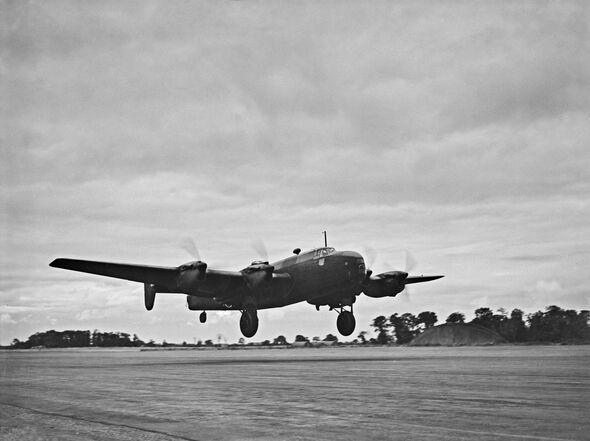
An RAF Halifax bomber takes off ahead of a mission (Image: Popperfoto via Getty)
It is three weeks before the Allied invasion of Italy and a Halifax bomber is surging down a runway and lifting off into a darkening sky from a top-secret RAF airfield in Bedfordshire. Seven young airmen are on board. Their mission, codenamed Operation Pimento, involves parachuting vital war materiel to members of the Resistance deep in the French Alps.
The Allies have taken Sicily and a full-scale invasion of Italy is due in three weeks’ time. The French guerrillas need the heavy explosives aboard the Halifax in order to sabotage the German counter-offensive that is expected to follow. Failure could prolong the war. Flying low and by moonlight, the huge four-engined bomber arrives at the drop zone near Annecy in south-eastern France at around 3am, but the crew can’t spot their reception party’s torchlights. The skipper circles the valley, perilously low. Snowcapped mountains loom either side of the aircraft and church spires whizz past. No lights flicker.
Just as the captain is thinking about aborting the mission, the aircraft shudders violently and the outer starboard engine conks out. Over the intercom, he orders the crew to jettison their load before telling the flight engineer to switch over the fuel tanks. But moments later, the inner starboard engine splutters and dies too, locking the Halifax in a permanent, downward turn. What little altitude the aircraft had begins to dwindle.
The pilot orders the crew to crash stations, but already buildings are rushing up towards the Halifax, their tiles twinkling in the moonlight. He wracks his mind for a solution as the engines roar in protest and the smell of burning petrol fills the cockpit. The Halifax’s starboard wing clips a house, demolishing its upper half and setting it on fire. The fuselage slams into another building, killing six of the seven airmen instantly. Petrol in the fuel tanks catches fire and explodes, burning ferociously.
Trapped in their homes, five civilians perish in the fire, including Erminia, mother of Serge, three, and Olivier, one. “I remember it as if it was yesterday,” one eyewitness later recalls, in an interview in the 1980s. “Exiting the house and seeing the terrible fire, the mangled aircraft sticking out of the house, the charred bodies of airmen on the ground. The air reeked of burning flesh for days.”
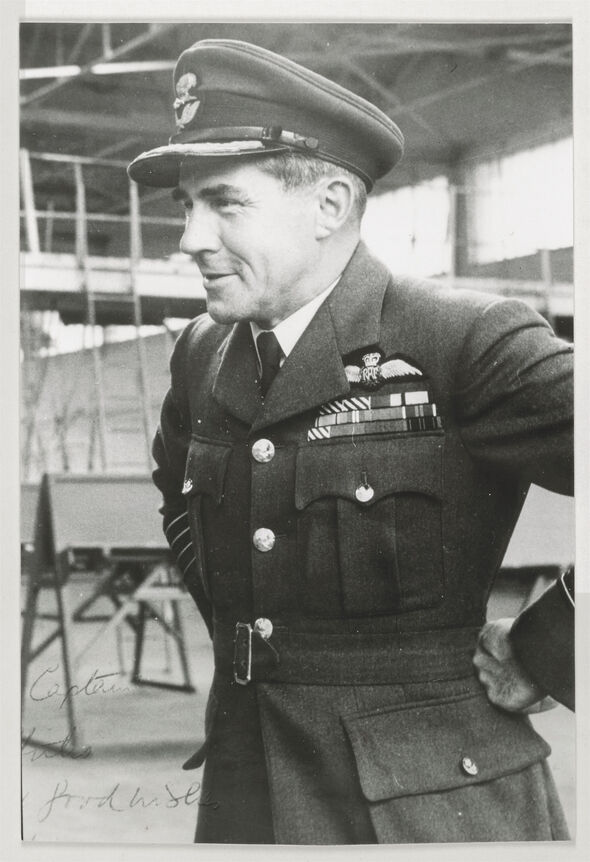
Squadron Leader Frank Griffiths, the sole survivor of Op Pimento and Adam Hart’s great-grandfather (Image: Courtesy Adam Hart)
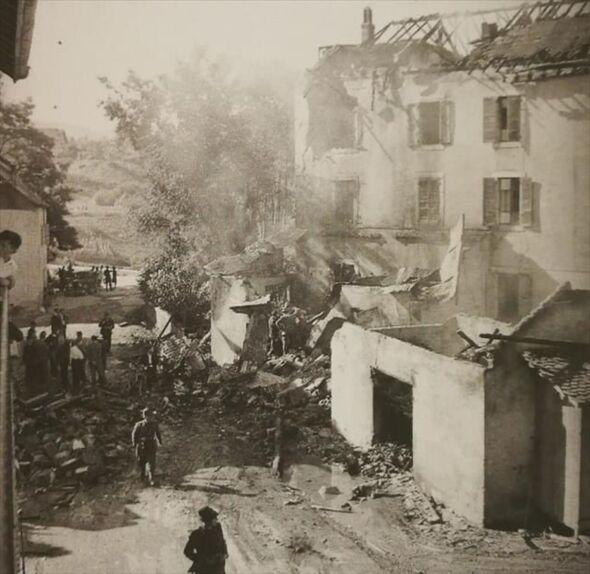
The remain’s of Frank Griffiths’ Halifax bomber in aftermath of wartime crash near Annecy (Image: Courtesy Adam Hart)
In a matter of seconds, 11 lives have been lost. Only one man emerges from the fiery wreckage, Squadron Leader Frank Griffiths. Later, he would describe it as his closest “brush with Reaper’s scythe”. But he is the reason I am writing this today. I am his great-grandson. Frank, catapulted from his cockpit still attached to his seat, soared across the night sky into some telephone wires which broke his fall and most probably saved his life.
Bleeding heavily, with a broken shoulder and wrist, he staggered from the fire before passing out. Regaining consciousness, he set off again, but soon vomited, spitting out blood and bits of broken teeth.
A 14-year-old boy called René approached on a bicycle. “Get on my bike, I will take you to safety,” he said. He folded Frank over the handlebars and pushed him to his mother Angéline’s house up the road. She shrieked when she saw Frank but quickly began administering first aid. The rest of the Fontaine family gathered around Frank, undressed him, burnt his English clothes and were about to redress him in local French ones when they heard gunfire outside. They bundled Frank into their chimney in his underpants. But it was a false alarm – the firing was just Italian soldiers trying to flush out “survivors” from a nearby wood.
“I had a wife and a child in England who I hoped I might one day see again,” remembered Frank in his memoir. “I confided this to the folks in the room and for some reason the women started crying.” Members of the local Resistance arrived and drove Frank to a restaurant-cum-brothel called Ma Baraque.
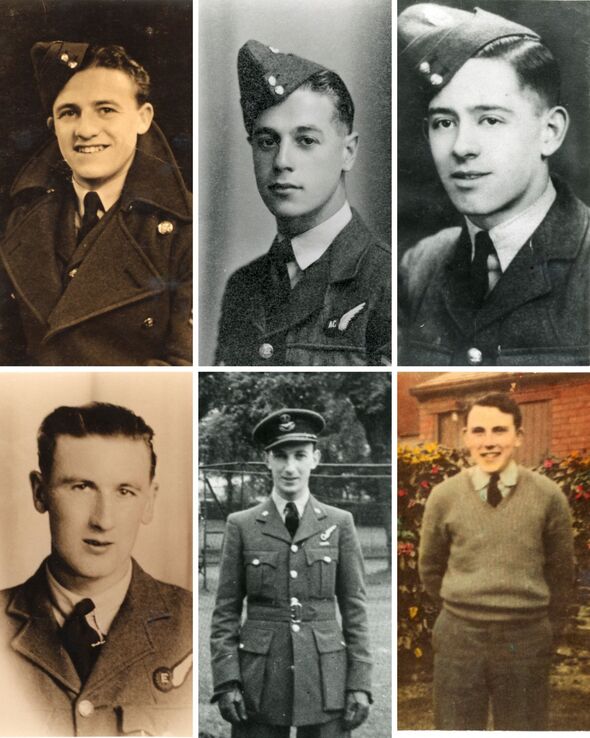
The six young RAF airmen who never made it home (Image: Courtesy Adam Hart / Hodder)

Author Adam Hart at the memorial to the heroic Operation Pimento airmen (Image: Courtesy Adam Hart)
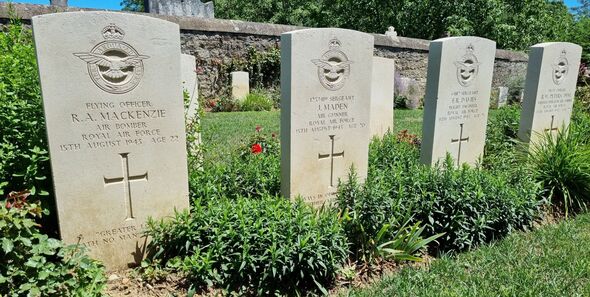
Final resting places of the Operation Pimento Crew in St Germain (Image: Courtesy Adam Hart)
Frank was taken to an upstairs bedroom, where he lay bedbound for three days. On his third day, Italian soldiers (the occupying force in this part of France at the time) entered the bar to drink. Frank lay motionless above, listening to their chit-chat drifting through the floorboards. Frank was moved to another safe house in the tiny hamlet of Les Goths. His host, a mother of one called Mimi Pallud, agreed to shelter him, despite every German and Italian in the area searching for the pilot who had survived the crash. She told her neighbours Frank was a distant relative who had escaped from the local lunatic asylum.
After a week recovering, the Resistance enacted their plan to smuggle Frank into the safety of neutral Switzerland. Driven to within a few miles of the border, Frank was joined by a pretty 22-year-old woman called Colette. Hand in hand, they strolled through the hay towards the border fence, pretending to be lovers to allay suspicion. “It was ghastly, worse than crossing the Dutch coast at nought feet on a moonlit night,” Frank recalled.
As darkness fell, the pair arrived at a farmhouse owned by Léon Mérandon, a First World War veteran who despised Germans. He had loosened some of the border fence for the pair to scramble under once darkness fell. The plan worked, and Frank found himself running across a field into Switzerland. “Colette whispered ‘Libre!’” remembered Frank, “but I couldn’t reply. I just took her hand and squeezed it.”
My great-grandfather was safe, but only temporarily. He remained in Switzerland until his injuries were healed. He was then given a choice: remain in Switzerland for the rest of the war, or re-enter France (which had been occupied by the Germans since his crash) and attempt to escape back to Britain.
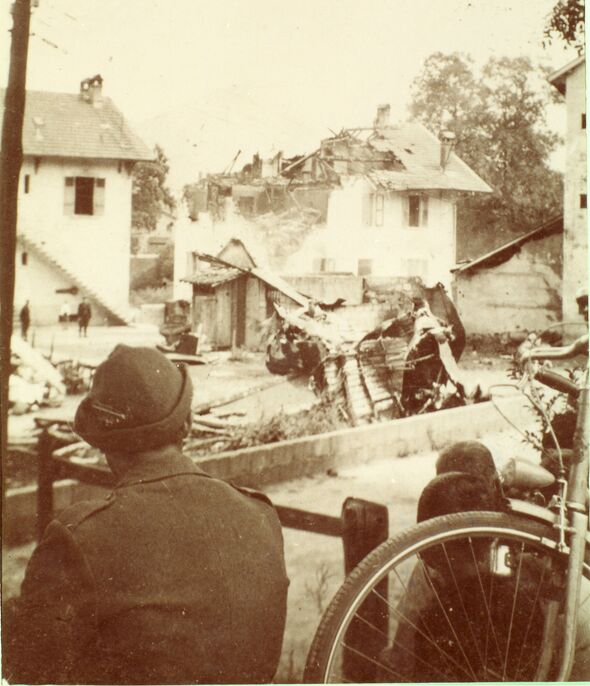
Devastation after the Halifax crash… yet Griffiths walked away and escaped (Image: Courtesy Adam Hart)
“I went through a traumatic period of self-analysis,” Frank recalled of the time. “I was now fairly fit and while my facial scars showed, they didn’t look too recent. If I wished, I could be interned with the other aircrews in Switzerland, but I knew it was my duty to get back to England and carry on with the war. But there was another reason that far transcended this call to duty and that was the strongest force in man; the desire to get back to a certain woman… and she was in England.” Frank chose to escape.
Some 79 years after Frank’s catastrophic arrival in France, I arrived at the exact spot he had crashed. It was the starting point of my journey. Despite being a freshly graduated 22-year-old, I wasn’t heading to Ibiza but to France to retrace my great-grandfather’s arduous escape from the Nazis almost 80-years-ago.
A stone memorial in the shape of a Halifax tail commemorates the events of August 15, 1943. Names of civilians killed are inscribed in the stone, as well as Frank’s crew who, staggeringly, had an average age of just 23.
Half a mile away in the local cemetery, I visited the graves of Frank Pollard, a 22-year-old rear gunner from Bury, and John Congdon, a 26-year-old navigator from Tiverton, (the other four airmen were transferred to a Commonwealth War Grave in the 1970s). Their headstones faced the magnificent Plateau des Glières. It made me think of the wonderful holidays I had enjoyed in the Alps and how these young men had almost certainly never visited there for pleasure – but ended up being buried there.
Physically retracing Frank’s footsteps was not my only reason for making the trip. At the crash site, I met Marie-Annick and Samuel, grand-daughter and great-grandson of Angéline Fontaine, the woman who first cared for Frank and hid him. It was the first in a series of extraordinary meetings with descendants of those who risked their lives to save him and get him back to Britain.
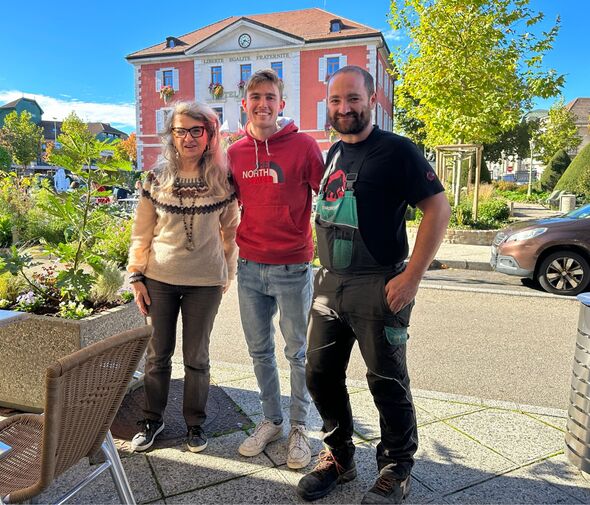
Adam meets Marie-Annick, left, and Samuel, right, two descendants of heroine Angéline Fontaine (Image: Courtesy Adam Hart)
Samuel, a mechanic in overalls who had blagged the afternoon off work to meet me, crushed my hand in a vice-like handshake before buying me the first of several beers. We talked at length about the events of August 15, 1943, the pair of them barely taking their eyes from me in three hours of conversation, despite the language barrier.
Later, I met Mimi Pallud’s daughter Josette, the woman who had told her neighbours Frank had escaped the local asylum. Now 80, she was a baby when Frank visited in 1943.
Entering Josette’s flat, she clapped her hands to her face in a gasp as tears collected in her eyes. Josette told me Frank had held her in his arms in 1943 and had thought of his own baby at home, my grandmother Tessa.
On the Swiss border, I met the Mérandon family at the very farmhouse Frank and Colette had sheltered in before making their final scramble into Switzerland. They told me that, for the rest of his life, Léon, maintained it was his “greatest honour” to help an RAF pilot. This from a man who had fought in the trenches before helping scores of Jewish schoolchildren flee to Switzerland.
After recovering in Switzerland, Frank was guided south across France under the noses of the Nazis before completing a brutal hike over the Pyrenees to Spain at night. Franco’s fascist police arrested and imprisoned him, however, and he spent a miserable week in a filthy jail.

Operation Pimento tells of Adam Hart’s journey in his heroic great-grandfather’s footsteps (Image: Hodder)
Thankfully, his release from prison was secured and after 108 days on the run, Frank reached Gibraltar where he was flown home. The aircraft was struck by lightning en route and crash-landed in Britain, but this time nobody was hurt. Frank died in 1996, four years before I was born. It pains me that I never got to meet my great-grandfather, but in truth it was a miracle he made it to 83.
- Operation Pimento: My Great-Grandfather’s Great Escape, by Adam Hart (Hodder & Stoughton, £22) is out now















